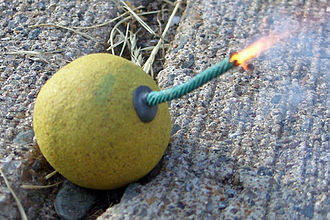Fuse (explosives)
Fuse (explosives)
A fuse is a device used in explosives to initiate the detonation of the explosive material. Fuses are critical components in both military and civilian applications, ensuring the controlled and timed detonation of explosives.
Types of Fuses
There are several types of fuses used in explosives, each designed for specific applications and environments:
- Safety fuse: A slow-burning fuse used to ignite black powder or other low explosives. It is commonly used in fireworks and blasting operations.
- Detonating cord: A high-speed fuse that contains a core of high explosive material, such as PETN or RDX. It is used to transmit a detonation wave to multiple explosive charges.
- Electric fuse: An electrically initiated fuse that uses an electric current to ignite the explosive material. It is often used in demolition and mining operations.
- Shock tube: A hollow plastic tube filled with a reactive powder that transmits a shock wave to initiate the detonation of an explosive charge.
Components of a Fuse
A typical fuse consists of several key components:
- Ignition source: The component that initiates the burning or detonation of the fuse. This can be a match, electric spark, or chemical reaction.
- Burning core: The material that burns or detonates to transmit the ignition to the explosive charge. This can be a slow-burning powder or a high-explosive material.
- Protective casing: The outer layer that protects the burning core from environmental factors such as moisture and physical damage.
Applications
Fuses are used in a variety of applications, including:
- Military: Fuses are used in grenades, bombs, and artillery shells to ensure the controlled detonation of the explosive payload.
- Mining: Fuses are used to initiate the detonation of explosives for rock blasting and ore extraction.
- Construction: Fuses are used in demolition to safely bring down structures.
- Fireworks: Fuses are used to ignite the various effects in fireworks displays.
Safety Considerations
Handling and using fuses require strict safety protocols to prevent accidental detonation. Key safety measures include:
- Proper storage of fuses in a cool, dry place away from sources of ignition.
- Use of appropriate personal protective equipment (PPE) such as gloves and safety glasses.
- Adherence to manufacturer guidelines and regulatory standards for the handling and use of fuses.
Related Pages
Transform your life with W8MD's budget GLP-1 injections from $125.
W8MD offers a medical weight loss program to lose weight in Philadelphia. Our physician-supervised medical weight loss provides:
- Most insurances accepted or discounted self-pay rates. We will obtain insurance prior authorizations if needed.
- Generic GLP1 weight loss injections from $125 for the starting dose.
- Also offer prescription weight loss medications including Phentermine, Qsymia, Diethylpropion, Contrave etc.
NYC weight loss doctor appointments
Start your NYC weight loss journey today at our NYC medical weight loss and Philadelphia medical weight loss clinics.
- Call 718-946-5500 to lose weight in NYC or for medical weight loss in Philadelphia 215-676-2334.
- Tags:NYC medical weight loss, Philadelphia lose weight Zepbound NYC, Budget GLP1 weight loss injections, Wegovy Philadelphia, Wegovy NYC, Philadelphia medical weight loss, Brookly weight loss and Wegovy NYC
|
WikiMD's Wellness Encyclopedia |
| Let Food Be Thy Medicine Medicine Thy Food - Hippocrates |
Medical Disclaimer: WikiMD is not a substitute for professional medical advice. The information on WikiMD is provided as an information resource only, may be incorrect, outdated or misleading, and is not to be used or relied on for any diagnostic or treatment purposes. Please consult your health care provider before making any healthcare decisions or for guidance about a specific medical condition. WikiMD expressly disclaims responsibility, and shall have no liability, for any damages, loss, injury, or liability whatsoever suffered as a result of your reliance on the information contained in this site. By visiting this site you agree to the foregoing terms and conditions, which may from time to time be changed or supplemented by WikiMD. If you do not agree to the foregoing terms and conditions, you should not enter or use this site. See full disclaimer.
Credits:Most images are courtesy of Wikimedia commons, and templates, categories Wikipedia, licensed under CC BY SA or similar.
Contributors: Prab R. Tumpati, MD

